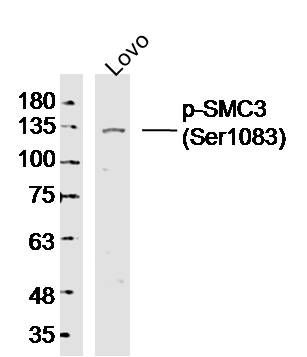
Anti-phospho-SMC3 (Ser1083)抗体
产品名称: Anti-phospho-SMC3 (Ser1083)抗体
英文名称: phospho-SMC3 (Ser1083)
产品编号: YB--19928R
产品价格: null
产品产地: 中国/美国
品牌商标: Ybscience
更新时间: 2023-08-17T10:29:50
使用范围: 科研使用
上海钰博生物科技有限公司
- 联系人 : 陈环环
- 地址 : 上海市沪闵路6088号龙之梦大厦8楼806室
- 邮编 : 200612
- 所在区域 : 上海
- 电话 : 183****2235 点击查看
- 传真 : 点击查看
- 邮箱 : shybio@126.com
- 二维码 : 点击查看
Anti-phospho-SMC3 (Ser1083)抗体
| 产品编号 | YB-19928R |
| 英文名称 | phospho-SMC3 (Ser1083) |
| 中文名称 | 磷酸化基底膜相关软骨素蛋白多糖抗体 |
| 别 名 | SMC3 (phospho S1083); p-SMC3 (phospho S1083); CDLS2; DKFZp686L19178; DXhXs423e; DXS423E; KIAA0178; MGC138332; OTTHUMP00000061876; RP6 29D12.1; SB1.8; Segregation of mitotic chromosomes 1; Segregation of mitotic chromosomes like 1; SMC 1; SMC protein 1B; SMC-1-beta; SMC-1B; SMC1; SMC1A; SMC1alpha; SMC1alpha protein; SMC1B; SMC1B_HUMAN; SMC1BETA; SMC1beta protein; SMC1L1; SMC1L2; SMCB; Structural maintenance of chromosome 1 like 1 protein; Structural maintenance of chromosome 1 like 2 protein; Structural maintenance of chromosomes 1A; Structural maintenance of chromosomes 1B; Structural maintenance of chromosomes protein 1B. |
| 规格价格 | 100ul/1580元 购买 大包装/询价 |
| 说 明 书 | 100ul |
| 产品类型 | 磷酸化抗体 |
| 研究领域 | 肿瘤 细胞生物 信号转导 细胞周期蛋白 转录调节因子 表观遗传学 |
| 抗体来源 | Rabbit |
| 克隆类型 | Polyclonal |
| 交叉反应 | Human, Mouse, Rat, Dog, Pig, Cow, Horse, Rabbit, Sheep, |
| 产品应用 | WB=1:500-2000 ELISA=1:500-1000 IHC-P=1:400-800 IHC-F=1:400-800 ICC=1:100-500 IF=1:100-500 (石蜡切片需做抗原修复) not yet tested in other applications. optimal dilutions/concentrations should be determined by the end user. |
| 分 子 量 | 141kDa |
| 细胞定位 | 细胞核 |
| 性 状 | Lyophilized or Liquid |
| 浓 度 | 1mg/ml |
| 免 疫 原 | KLH conjugated synthesised phosphopeptide derived from human SMC3 around the phosphorylation site of Ser1083.:SG(p-S)QS- |
| 亚 型 | IgG |
| 纯化方法 | affinity purified by Protein A |
| 储 存 液 | 0.01M TBS(pH7.4) with 1% BSA, 0.03% Proclin300 and 50% Glycerol. |
| 保存条件 | Store at -20 °C for one year. Avoid repeated freeze/thaw cycles. The lyophilized antibody is stable at room temperature for at least one month and for greater than a year when kept at -20°C. When reconstituted in sterile pH 7.4 0.01M PBS or diluent of antibody the antibody is stable for at least two weeks at 2-4 °C. |
| PubMed | PubMed |
| 产品介绍 | background: This gene belongs to the SMC3 subfamily of SMC proteins. The encoded protein occurs in certain cell types as either an intracellular, nuclear protein or a secreted protein. The nuclear form, known as structural maintenance of chromosomes 3, is a component of the multimeric cohesin complex that holds together sister chromatids during mitosis, enabling proper chromosome segregation. Post-translational modification of the encoded protein by the addition of chondroitin sulfate chains gives rise to the secreted proteoglycan bamacan, an abundant basement membrane protein. [provided by RefSeq, Jul 2008] Function: Central component of cohesin, a complex required for chromosome cohesion during the cell cycle. The cohesin complex may form a large proteinaceous ring within which sister chromatids can be trapped. At anaphase, the complex is cleaved and dissociates from chromatin, allowing sister chromatids to segregate. Cohesion is coupled to DNA replication and is involved in DNA repair. The cohesin complex plays also an important role in spindle pole assembly during mitosis and in chromosomes movement. Subcellular Location: Nucleus. Chromosome. Chromosome > centromere. Associates with chromatin. Before prophase it is scattered along chromosome arms. During prophase, most of cohesin complexes dissociate from chromatin probably because of phosphorylation by PLK, except at centromeres, where cohesin complexes remain. At anaphase, the RAD21 subunit of the cohesin complex is cleaved, leading to the dissociation of the complex from chromosomes, allowing chromosome separation. Post-translational modifications: Phosphorylated upon DNA damage, probably by ATM or ATR. Acetylation at Lys-105 and Lys-106 by ESCO1 is important for genome stability and S phase sister chromatid cohesion. Regulated by DSCC1, it is required for processive DNA synthesis, coupling sister chromatid cohesion establishment during S phase to DNA replication. DISEASE: Defects in SMC3 are the cause of Cornelia de Lange syndrome type 3 (CDLS3) [MIM:610759]. CDLS is a dominantly inherited multisystem developmental disorder characterized by growth and cognitive retardation, abnormalities of the upper limbs, gastroesophageal dysfunction, cardiac, ophthalmologic and genitourinary anomalies, hirsutism, and characteristic facial features. CDSL3 is a mild form with absence of major structural anomalies typically associated with CDLS. The phenotype in some instances approaches that of apparently non-syndromic mental retardation. Similarity: Belongs to the SMC family. SMC3 subfamily. SWISS: Q9UQE7 Gene ID: 9126 Database links: Entrez Gene: 395188 Chicken Entrez Gene: 281729 Cow Entrez Gene: 9126 Human Entrez Gene: 13006 Mouse Entrez Gene: 29486 Rat Entrez Gene: 399092 Xenopus laevis Entrez Gene: 324475 Zebrafish Omim: 606062 Human SwissProt: Q9UQE7 Human SwissProt: Q9CW03 Mouse SwissProt: P97690 Rat SwissProt: O93309 Xenopus laevis Unigene: 24485 Human Unigene: 14910 Mouse Unigene: 11074 Rat Unigene: 290 Xenopus laevis Unigene: 75355 Xenopus laevis Important Note: This product as supplied is intended for research use only, not for use in human, therapeutic or diagnostic applications. |
| 产品图片 |
 Sample: LOVO Cell (Human) Lysate at 40 ug
Primary: Anti-p-SMC3(Ser1083) (bs-19928R) at 1/300 dilution Secondary: IRDye800CW Goat Anti-Rabbit IgG at 1/20000 dilution Predicted band size: 141 kD Observed band size: 135 kD |
